
I’m not trying to be ‘African’. I’m not trying to prove anything. If you want to doubt if it’s African, look at the material the art is made of and look at the person making it. So I’m using local materials and the concepts I put across are indigenous to this place. I actually hate the title ‘African art’ because titles are for people who want to gain from this.
Matt Kayem interviews Waswad
Installation View, Afriart Gallery, 2020
Tracking Down Waswad
The chaotic 2020 is finally coming to an end and as we here in Uganda are still grumping with the political situation, Waswad springs up from the disarray to take us away from our misery. This time, he takes us on a journey to a far off land in the northern part of the country, Napak. Wasswa Donald August, popularly known as Waswad opened his fourth solo show at Afriart gallery to a bunch of excited brave art goers. Brave, well, because it’s precarious to be moving around this dusty city these days with the riots and covid situation. With all this though, I managed to convince Waswad to sacrifice a few hours from his busy work schedule to chat about his practice and his most recent show Down In Napak at Afriart gallery. I quizzed him about his recent show and the work he showed, activism in art, design, his inspirations and many more. Waswad has two studio spaces, one at his home and another one in Bukansa, one of the suburbs in Kampala of which I got a chance to visit. At the quiet well-lit space, he said he usually works on painting and drawing here because of the low-noise levels in the area. And when it’s time to bang the wood to produce his alien-like beings, he stays at the home studio. It’s been a while now that the artist has been looking into the future of man as placed alongside the inevitable forces of science and technology. From To Live Is To Become(2017) and Degenerative Evolution of The Living(2018) which are two of his past bodies of work, the artist continues in the same spirit with this new one, expounding on his darling theme. It’s a Friday afternoon and after the directing on calls, me and my photographer get to the artist’s studio. We find Waswad preparing small long sticks to design a prototype or probably a maquette for a sculpture which I never asked much about. So we chat away as he cuts, glues and assembles the little trial version of something big.
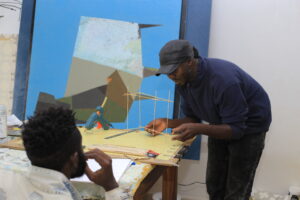
Waswad working on a prototype as he chats with me in his studio.
MK: What caught my attention first with your new body of work at Afriart gallery was the title. Was it the curator’s or of your own making and how does it invite the viewer to engage with the work?
WDA: There is some music I usually like to listen to, I listen to a lot of music but there is Kate Bush who has like two songs I know. For this title, I got it from an English band who put out a song I think in 1978, it’s called Down in The Park, the story is about the mach-men or the machine men. In the song, there is this park where these robots or mach-men meet and they hunt down human beings. That’s the message in the song, they hunt down human beings for their pleasure and fun. When I had that song, I felt that it related a lot with my work because it’s almost the same thing I talk about. At some point, the curve will change and all that we’ve created will turn against us and wipe us out or replace us. So I realized that the message is almost the same. But I wanted to get a name I relate to back home and I asked myself which place is that and of course I’ve never been to Napak in Karamoja. But I loved the name Napak because it rhymed with “in the Park”. First of all, I thought of a place I’ve never been that is remote and along the way I thought maybe I known place is not fit for a title because people who come from there might not agree. They would go like he’s referring to us, that we are backward but along the way I suspended it thinking that it cannot stop my idea. Actually, I used the name Napak but it can be anything because this is an imaginary world of course things are not yet happening but I’m imagining what is likely to happen. I think also, there is a place called Napak in India, stumbled on it when I was doing my little research.

Installation View, Afriart Gallery, 2020
MK: There is the installation in the middle of the exhibition room with a signpost Down in Napak.
WDA: The whole body of work is called Down in Napak. So the installation was a collaboration, the curator, Michelle Mlati had ideas and at some point I thought time was not on our side but at the end I agreed for us to do it. But for me what I presented, the whole collection is Down In Napak and the installation shares the name too we could say and she actually put that sign post in but I had objected to it sighting that it was trying to prove a point. But anyway, she was the curator so you also let her enjoy making the show but as an artist, you usually have something else you are thinking of. In fact when I read her exhibition statement, it seemed to say and she asked me…I told her that I’m not addressing issues to do with deforestation or that sort of thing, hehe. My work is totally away from that, I can’t be the guy saying oh, let’s stop cutting down trees. And she was asking me about what I think about the show and I had no answer, maybe I could have one after some time. But when you look, if I wasn’t the artist, at the greenery and the tree stamps with the work on top, it shows you the stages, from the earth to the finished product.
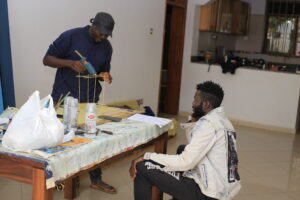
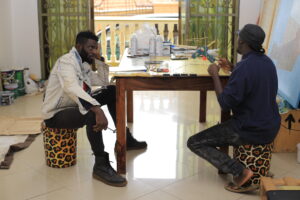
I interview Waswad, 2020
MK: So how long have you been working on this body of work?
WDA: I’m always working, I only got to know of the show I think in August, okay, Daudi Karungi had told me about a show I think last year. And I thought I should be ready with work and then this year, covid happened. I wasn’t set because he told me two or three times, reminding me. Then this year, Michelle wants to meet me and she suggested, I think that was when August was ending but I was a little hesitant.
*
MK: When you are working, do you already know that such a work belongs to this collection or you just produced everything collectively?
WDA: Aaah, I do, what can I call it. I might be working on this body of work and seeing the results and if satisfied, I continue working, one piece will lead to another and another. But along the way, I might get something else that excites me, there is something else I wanna talk about, I first take a break. At times it’s more like satisfying myself, so many things happen and if I find that I am capable of doing something else and then I jump unto that. Sometimes I might continue and get the satisfaction I was yearning for and then I go back to the old. So I continue working and there is some work I did and have never shown it and I know they are not part of this. And if somebody tells you there is possibility for a show, you have to think of what you are going to show. At times, If you are working on something and people haven’t seen it or seen it online, it’s good you present it and they see it physically before you jump unto something else. So they were suggesting October and I was like I’m not ready then. And I thought I didn’t have enough work and on the day of the opening, I went there and I was like, “wow” because my mind was showing me something else to what I saw in the gallery space. You know, when we talk about a show, I usually have something I think of and at times, the gallerist or curator has different ideas too.
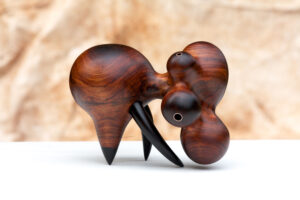
BIRABWA, 2019, 31 x 22 x 27 cm, Albizia ebony Wood, Copper
MK: I know your sculptures and drawings but I saw leather works in this collection. What about these and what do you call them?
WDA: So I called them Immortal Objects but the general term would be sculptures, they are sculptures too. So that work, when I got to know that I’m doing a show, that’s when I did the work, I used quite a short time because that’s what I was feeling at that time. But the other thing is, of course I have ever shown leather work but not in that fashion and I wanted people to experience this material in a different way. With these, I’m talking about the material, the time I’ve been with and also thinking about the process from when there is this living thing, from that time when it is growing with its skin to the point they kill it and skin it. After skinning, the skin goes to get processed and we get a new product. In the new product, they make other products. They discard the damaged or off cuts which I pick up because I got these from a factory which wanted to get rid of them. So this is the process these works talk about because these things have an unending life.
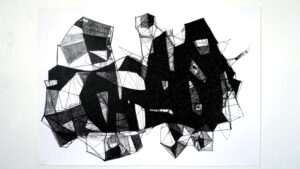
Kizungirizi KX, 20.1, 2020 charcoal on paper, 70 x 50 cm
MK: In your work, you use materials you source from your immediate environment like the tree trunks and your work I feel has always had an environmentalist edge to it. Would you consider to share the same ideals as the Greta Thunbergs of this world?
WDA: No I’m not. For me, I’m just talking about what I see and experience but I’m part of this whole nature thing. And I believe in evolution, that everything changes after some time. But the other thing I can say if I’m to talk about environment is that as a human being, I just have to be responsible within the surroundings that I occupy. I have to know and understand what I’m using and how it could affect my life. Yah, just being conscious but I can’t say that I want us to go back to the way things were. I don’t believe that it is possible to go back because I could be responsible but you may not. But in the long run, for example, when you look at plastic, it doesn’t rain from the sky, the human beings are it’s maker. But these human beings also get the raw materials to make these things from nature. So, in one way or another, we come to this earth and find what’s there and tamper with it, make many new things out of whatever is around. After consuming the new products, we throw away and somehow it goes back to the environment. Now, because we have tampered with the raw material to make something new, when we discard it, it goes back to the environment. It might take longer to go back to the state we expect it to but it still goes back and turns into whatever it becomes. For example, when we get oil from the earth, we make it into different products which go back making a cycle. It is a cycle at the end of the day.
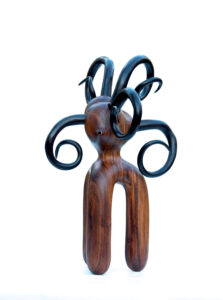
Nassanga, ebony wood, 2020, 56 x 45 x 68cm, Albizia, ebonywood & Copper
MK: Your work incites conversations about the future of man. Is it in any way connected or ignite conversations about technology?
WDA: Of course, Technology is like a tool we use to make our lives better so in one way or another, my work is about science and technology because it’s what we are using currently to improve our lives. We are born with intelligence and we experience situations that force us to innovate. But my work in general talks about me as a human being and how I relate to the immediate environment. Then I start imagining how it’s going to be in years to come. So when you see my sculptures, I’m imagining that whatever things we are doing, at times we consume but in the longs run, our activities and whatever we are getting out of this will over-power us at some point. I can say over-powering but at times it’s just part of what it has to be. And when that time reaches and of course we also go on changing to become other things.

Still life I, 2020, acrylic on canvas, 200 x 200 cm
MK: So what has always perplexed me about your work is that you are talking about technology, the future and aliens but you use organic materials in your work like the wood, bark-cloth sometime. I would have expected that you would use artificial technology related material like computer parts, metal and the like.
WDA: I think that’s so obvious and secondly, I believe that there is no science and technology that beats the one that comes from nature. You can study about how plants come to be but there is that deeper science or technology involved or that is invisible. And the other thing, I love using organic materials because I relate so much to them than I do to artificially man-made things. So I think I relate so much to wood, the soil, yah, basically these two components, soil as that raw material and wood because it’s where everything else comes from. You can talk about metal, stone or sand and all these come from soil.

Still Life, 2020, acrylic on canvas, 200 x 200 cm
MK: Tell me a little about your process of creating, from conception of the idea to executing it because as I remember, you told me yours is a spontaneous exercise where you don’t plan much and I thought that was interesting.
WDA: Actually, there is no big deal, it’s waking up, at times it’s not even waking up but being on a boda boda and you get this idea and then reaching home. No, I don’t sketch, I got fed up of that, you see I have to do this prototype. There is a way sketching gets in the way of the actual work because a sketch gives a different feel. So I start right way to execute when I have an idea, be it installations or anything when the idea is still raw or fresh. I get visions of what I want and it’s exact and at times if I sketch, I could edit and start losing some of the details. There always say and I have experienced it that when you have an idea, it’s advisable to just do it because that first take is always perfect.
*
MK: What I respect about you and your work is that you are not influenced by trends or what is selling out there. You know, the black figure is the hot cake right now.
WDA: I think they are just trying to make us buy things, you know, trends come and go. But you can jump on the trend and get a share of it but have you really satisfied yourself. I try to be as honest as possible so I don’t want to do something because I’m trying to please a certain market. When I find myself doing work in line with what’s on, well and good but I don’t intend to chase what’s trending. Yah, so I wouldn’t advise anybody to jump unto a trend because they want to sell because that’s cheating yourself.
*
MK: You reduce your images or sculptures to a few colors and simple design elements. How did you transcend to the way of working?
WDA: I think I’m a minimalist at heart, I want things simple and plain but with a meaning. I think life should be simple but although some people have noted and said that within that simplicity, there is some complexity. All the guys that inspire me work in a reduced simple way.

Installation View, Afriart Gallery, 2020
MK: Who are those that inspire you?
WDA: The taste keeps on changing. There is when liked this Austrian painter Gustav Klimt but his work is not as simple. I used to like his work way back when I was in university and even high school. But of course as you go on seeing different things, the taste changes too. I think every artist has a uniqueness you can pick up on, at times it’s what they advocate for or what they believe in or there actual work and how their influence. I would say that architects inspire me a lot, the likes of Tadao Ando, I like a lot of stuff from Japan because they have that bit of minimalism. I like Donald Judd’s work. There is this guy Richard Serra, I like Carl Andre, Mark Rothko at some point. Other guys are Rei Kawakubo, Zaha Hadid, Oscar Niemeyer, them down here in Africa, the bark-cloth making practice is a big a big inspiration for me, African architecture(mud architecture) in general. It’s always art and design for me.
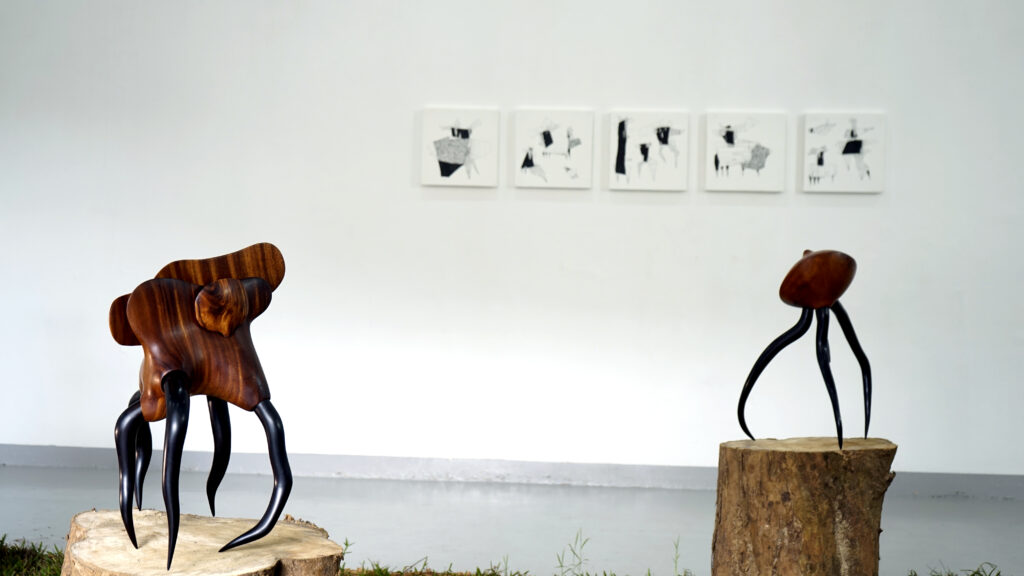
Installation View, Afriart Gallery, 2020
MK: You probably had comments like your work doesn’t fit into the accepted pool of ‘African art’.
WDA: Some people suggest that in a way but I’m not trying to be “African”. I’m not trying to prove anything. If you want to doubt if it’s African, look at the material the art is made and look at the person making it. So I’m using local materials and the concepts I put across are indigenous to this place. I actually hate the title ‘African art’ because titles are for people who want to gain from this.
